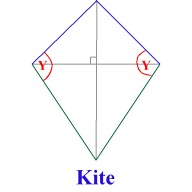

∠QRT = ∠PQR (alternate interior angles).PQ = RT (opposite sides of the parallelogram PQTR).To Prove: The diagonals PT and RQ bisect each other, i.e., PE = ET and ER = EQ.įirst, let us assume that PQTR is a parallelogram. PT and QR are the diagonals of the parallelogram. Theorem 3: Diagonals of a Parallelogram Bisect Each Other. We have to prove that ABCD is a parallelogram. Given: ∠A = ∠C and ∠B = ∠D in the quadrilateral ABCD.Īssume that ∠A = ∠C and ∠B = ∠D in the parallelogram ABCD given above. This proves that opposite angles in any parallelogram are equal.Ĭonverse of Theorem 2: If the opposite angles in a quadrilateral are equal, then it is a parallelogram. Thus, by ASA, the two triangles are congruent, which means that ∠B = ∠D. Let us assume that ABCD is a parallelogram. Given: ABCD is a parallelogram, and ∠A, ∠B, ∠C, ∠D are the four angles. Theorem 2: In a Parallelogram, the Opposite Angles are Equal. Therefore AB || CD, BC || AD, and ABCD is a parallelogram. Hence we can conclude that ∠BAC = ∠DCA, and ∠BCA = ∠DAC. Thus by the SSS criterion, both the triangles are congruent, and the corresponding angles are equal. AB = CD (since alternate interior angles are equal).Now compare the two triangles ABC, and CDA. N the quadrilateral ABCD we are given that AB = CD and AD = BC. Given: The opposite sides in a quadrilateral ABCD are equal, AB = CD, and BC = AD. Therefore we have AB = CD, and BC = AD.Ĭonverse of Theorem 1: If the opposite sides in a quadrilateral are equal, then it is a parallelogram. Hence by the ASA criterion, both the triangles are congruent and the corresponding sides are equal. ∠BCA = ∠DAC (alternate interior angles).∠BAC = ∠DCA ( alternate interior angles).In parallelogram ABCD, compare triangles ABC and CDA. To Prove: The opposite sides are equal, AB = CD and BC = AD. Theorem 1: In a Parallelogram the Opposite Sides are Equal.


The opposite sides of a rhombus are equal and parallel to each other.The sum of any two adjacent interior angles is 180°.The diagonals of a rhombus bisect each other at 90°.All sides of a rhombus are equal in length.Both the diagonals of a rectangle are of the same length.All four angles of a rectangle are equal and measure 90° each.The opposite sides of a rectangle are equal and parallel.The opposite sides of a square are equal and parallel to each other.Both the diagonals of a square have the same length.The diagonals of a square bisect its angles.All four angles are equal and of 90 degrees each.The three different parallelograms are square, rectangle, and rhombus which are different from each other because of their properties yet they all come under the category of parallelograms. Observe the following figure to understand the properties of a parallelogram.Īll the above properties hold true for all types of parallelograms, but now let us also learn about the individual properties of some special parallelograms. The opposite sides of a parallelogram are equal and parallel to each other. The consecutive angles of a parallelogram are supplementary, i.e.,.All the angles of a parallelogram add up to 360°, i.e., ∠A + ∠B + ∠C + ∠D = 360°.The opposite angles of a parallelogram are equal, i.e., ∠A = ∠C, and ∠B = ∠D.The important properties of parallelograms related to angles are as follows: Also, the properties are helpful for calculations in problems relating to the sides and angles of a parallelogram. Understanding the properties of parallelograms helps to easily relate its angles and sides. There are four angles in a parallelogram at the vertices. What are the Properties of Parallelogram?Ī parallelogram is a type of quadrilateral in which the opposite sides are parallel and equal.


 0 kommentar(er)
0 kommentar(er)
